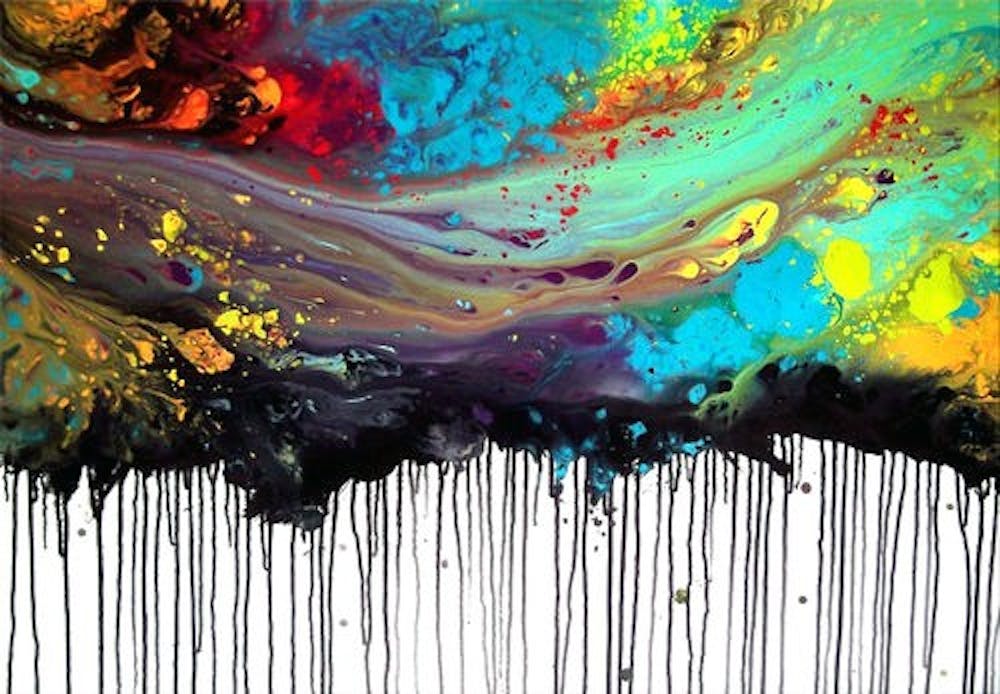It’s Tuesday morning and Wharton sophomore Ayo Fagbemi is walking along 36th Street on his way to campus. Ahead of him he sees university buildings and other students when the song “Cold Dead” by Flying Lotus comes on in his headphones. And then, in front of him, an electric purple haze diffuses to orange to dark pea green to ambient gray: he sees colors melting into the arpeggio of the song, shifting with the key changes.
It might sound like a trippy daydream, but this is how Ayo experiences music. He’s a member of the handful of Penn students who self-identify with the condition of synesthesia.
Often misrepresented as an involuntary, 24/7 acid trip, synesthesia is in fact a neurological condition in which sensory cognitive pathways are crossed, leading to multi–sensory perception. This sensation includes the audio/visual connection Ayo shares with musicians like Stevie Wonder and Pharrell. Like these artists, Ayo uses his condition in creating music as a member of a cappela group, the Inspiration—the colors help him keep track of tonality and emotional resonance.
For two other Penn musicians with synesthesia, sound and image are likewise linked.
Mitch Hung is a College junior who was informally diagnosed with audio/visual synesthesia by his introduction to experimental psych professor in office hours after a lecture on the condition. Mitch associates sounds with corresponding shapes and shades of gray. He loves creating and listening to music, and classifies it in an unusual way that reflects his unusual ears. Rather than jazz or acid house, Mitch’s favorite genre is “stuff that looks interesting. I’m always going for new, unique experiences.” So... Kesha.
Meanwhile, another college Junior, who asked to remain anonymous for this article, enjoys “spatial music” and strives to create certain visual, textural environments when playing his French horn or trumpet, which he makes time for every day.
 Although all three boys
have had the condition for
their entire lives, they all feel
their perception has changed
over time. Penn has been an
environment for discovery and
development of their synesthesia,
but seeing sound creates its
own odd problems on campus.
“Big lecture halls are the
worst,” Mitch explains. “Even
when I’m trying to listen to the
professor, I can still feel people
shuffling around and whispering.”
Although all three boys
have had the condition for
their entire lives, they all feel
their perception has changed
over time. Penn has been an
environment for discovery and
development of their synesthesia,
but seeing sound creates its
own odd problems on campus.
“Big lecture halls are the
worst,” Mitch explains. “Even
when I’m trying to listen to the
professor, I can still feel people
shuffling around and whispering.”
And you think you’re sorted with your studying playlist of exclusively Icelandic music so that you won't sing along? That doesn’t cut it for Ayo. “You know how people say it’s distracting to study listening to music with words? Well, for me it’s like all music has words,” he laughs.
For the unnamed junior, however, synesthesia is related to his general mental stability and stress levels. He experiences colors in association with his thoughts and feelings: his mom “has a papery feel: very bright yellow, sometimes drifting into light blues, purples." And love is the color and texture of a red brick. But at times in his life when he’s been under pressure, the synesthesia has become oppressive. “It’s in your head, so in that way it can be claustrophobic. The very best and worst moments of my life have been defined by the colors,” he muses. Since practicing transcendental meditation and gaining stability in his life, he has come to excercise better control and appreciate his condition. For better or worse “it’s part of who I am.”
Having such a unique, singular perspective could seem isolating, but no one I spoke to felt lonely on account of their synesthesia. “Everyone has something that’s unique to them, this is my thing,” Mitch explains. With synaesthesia or without, we each experience the world in our own peculiar way. Connection doesn’t come from similarity between us, but from communication.







